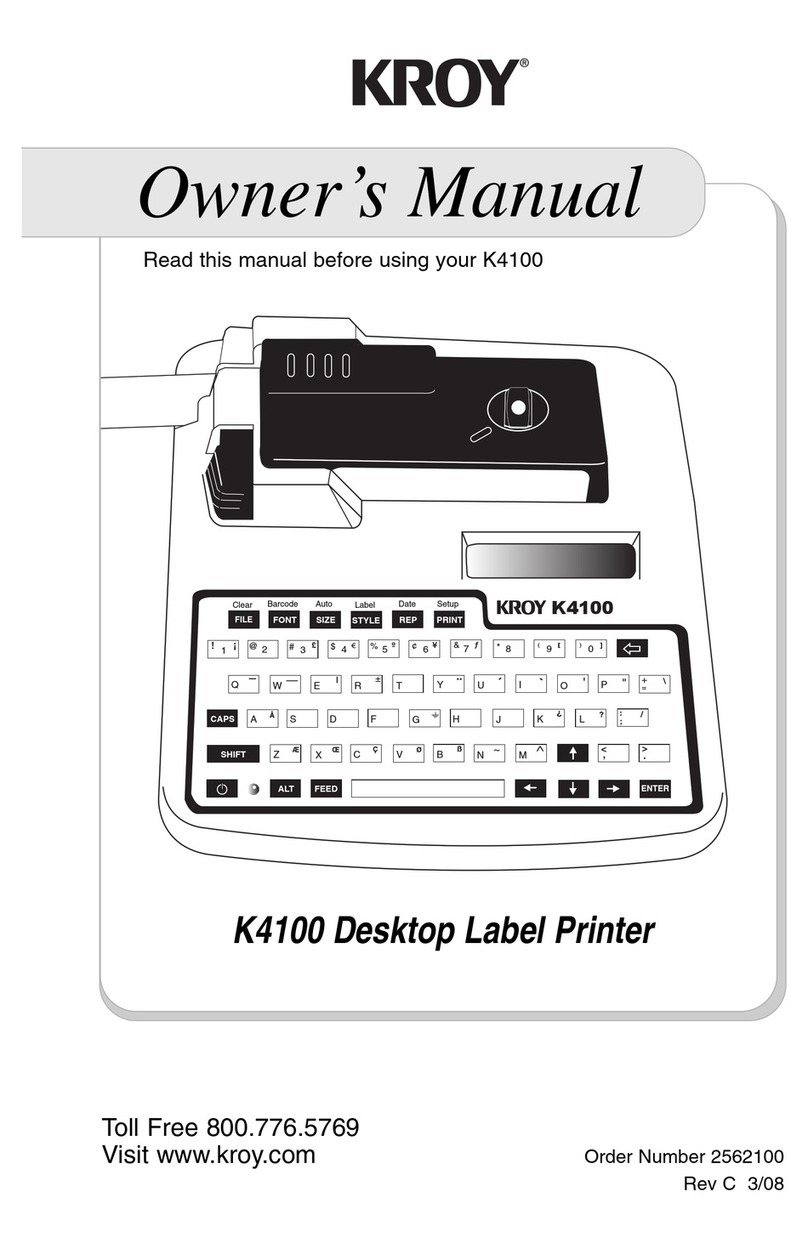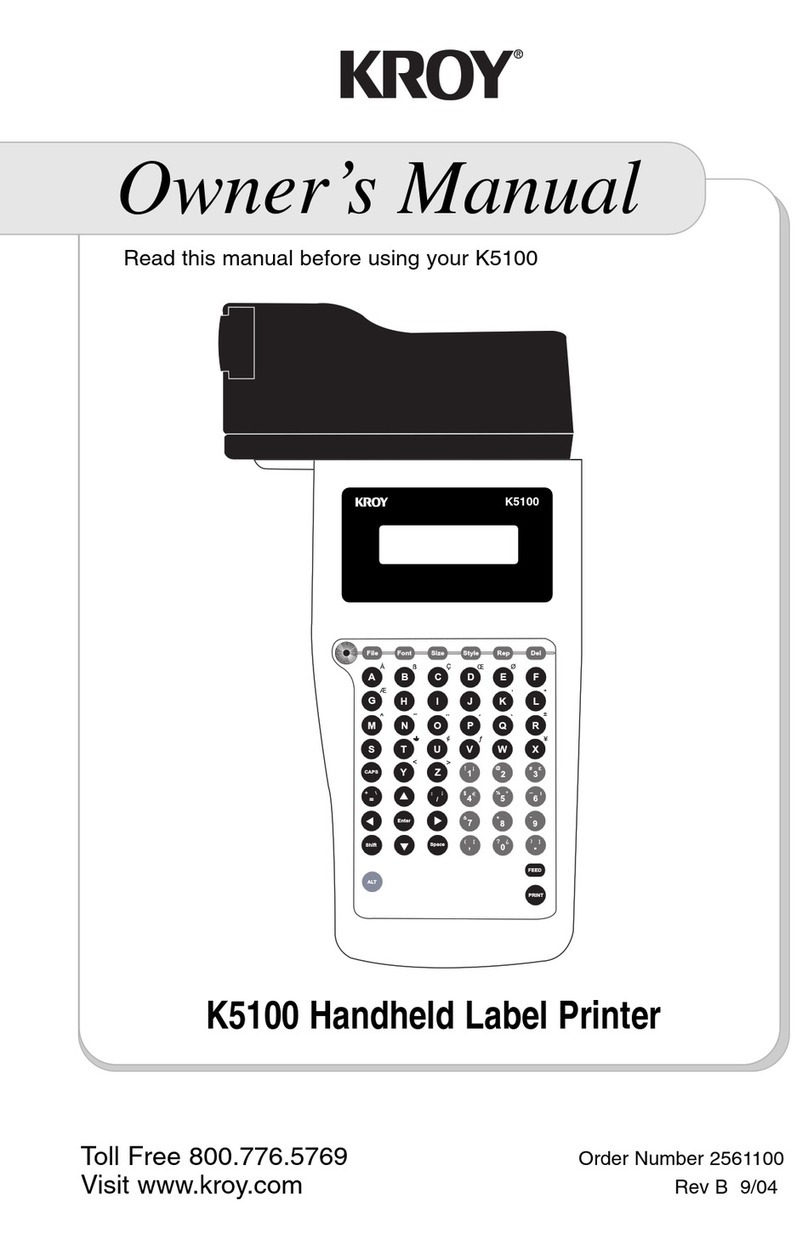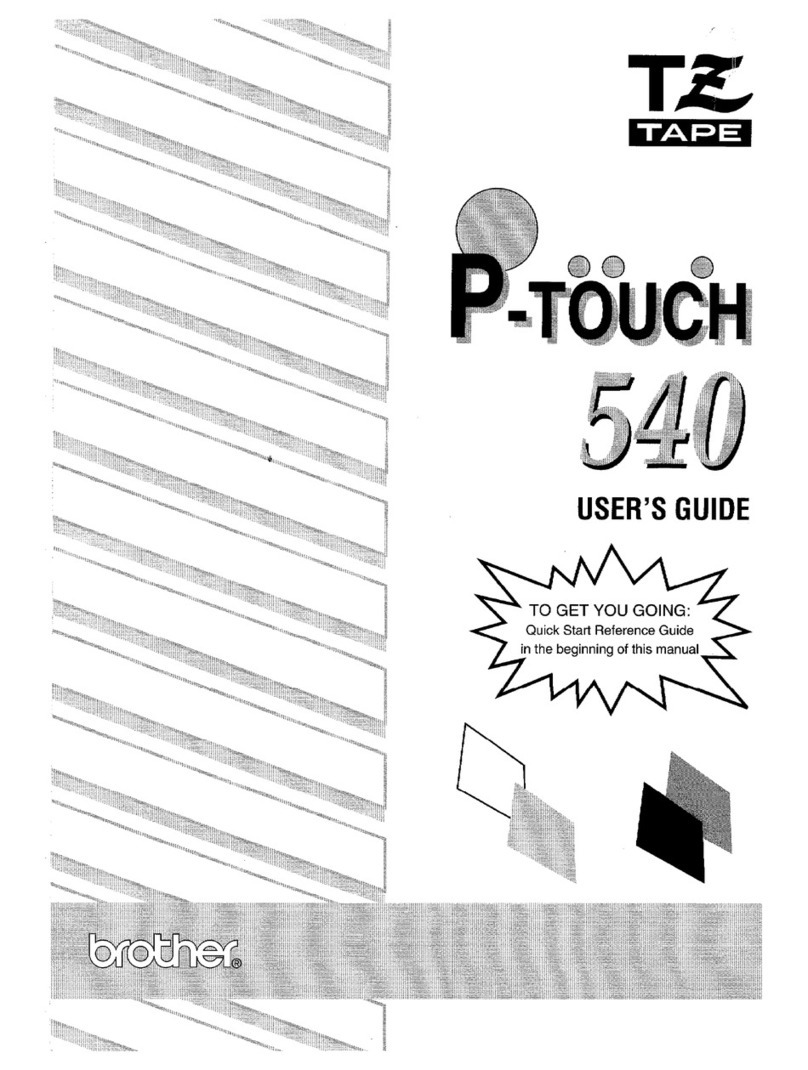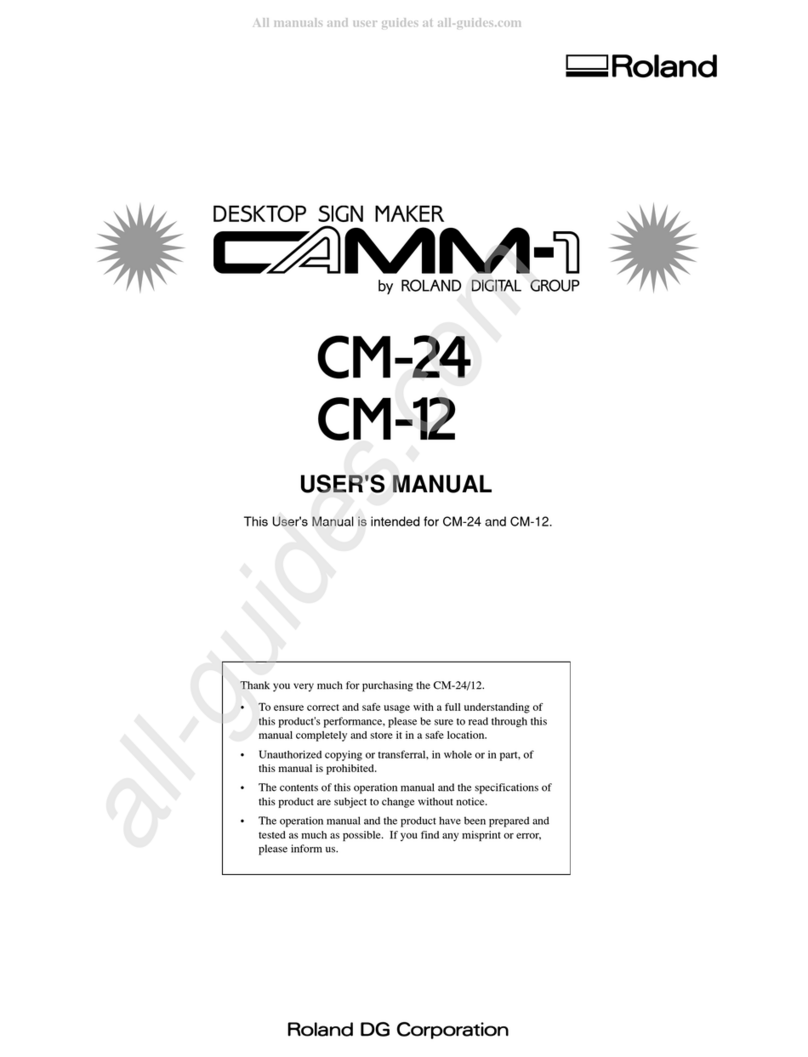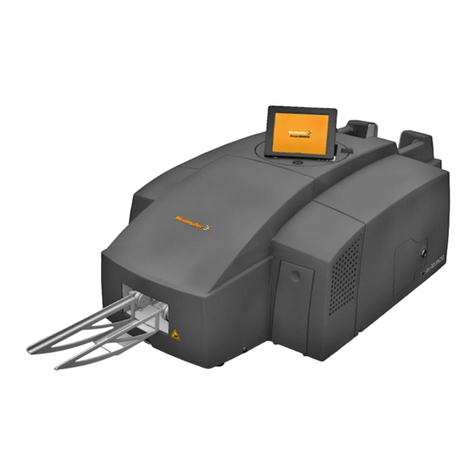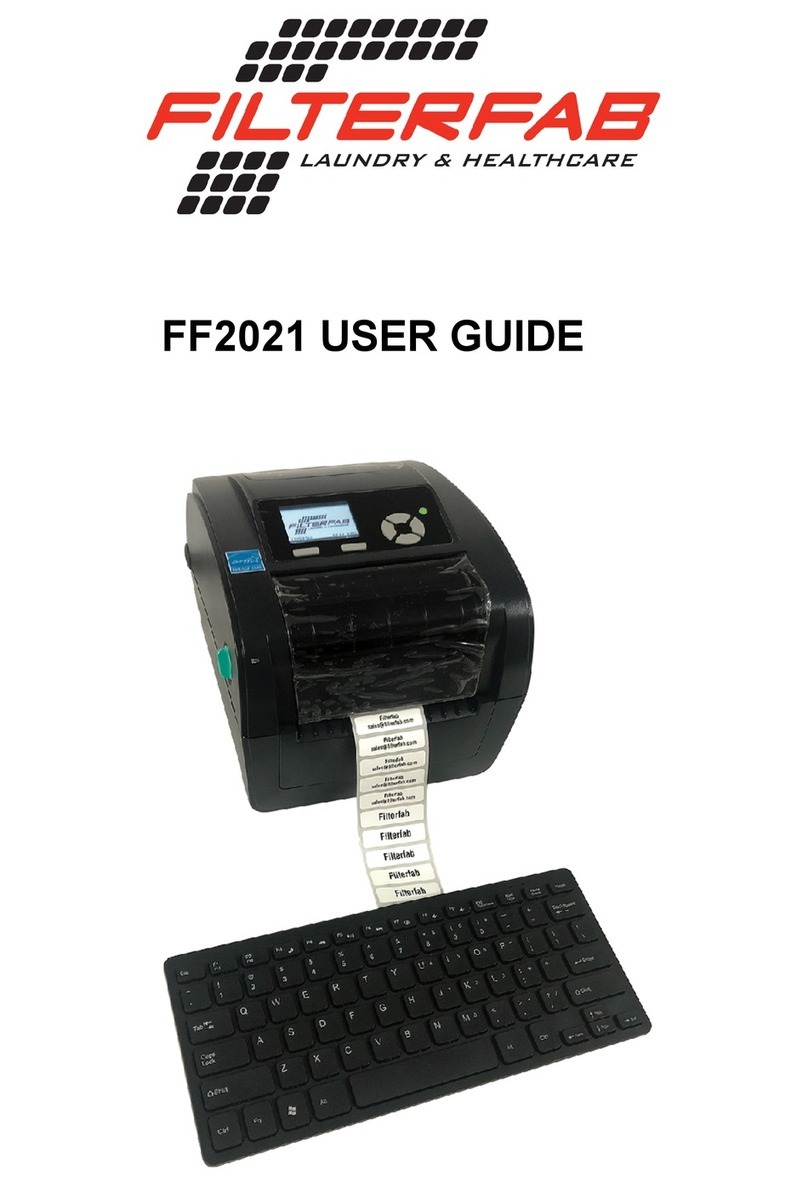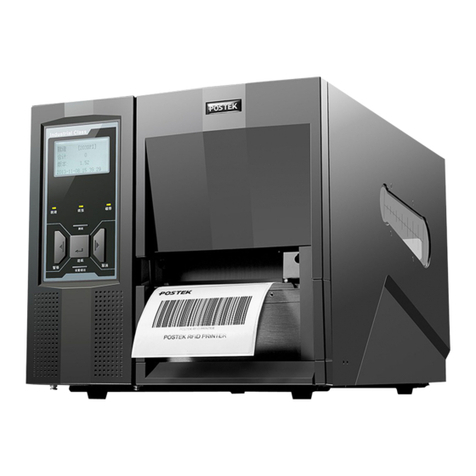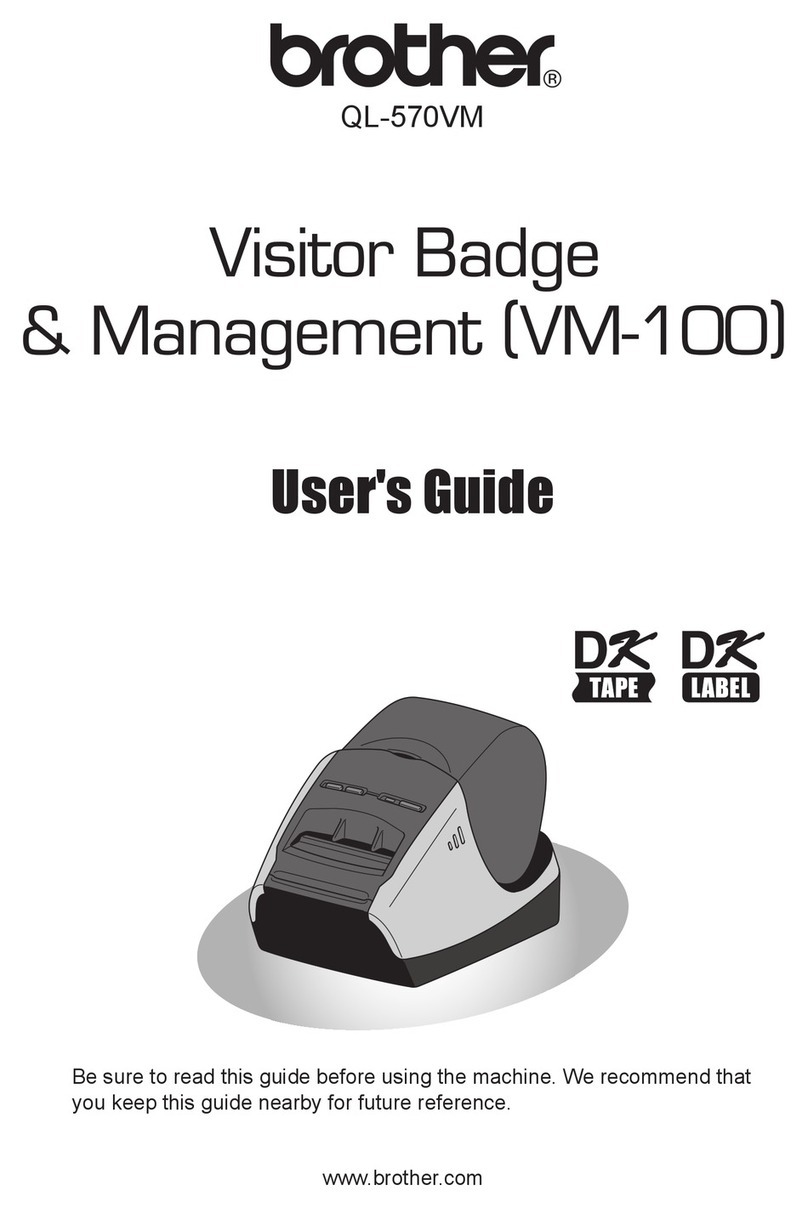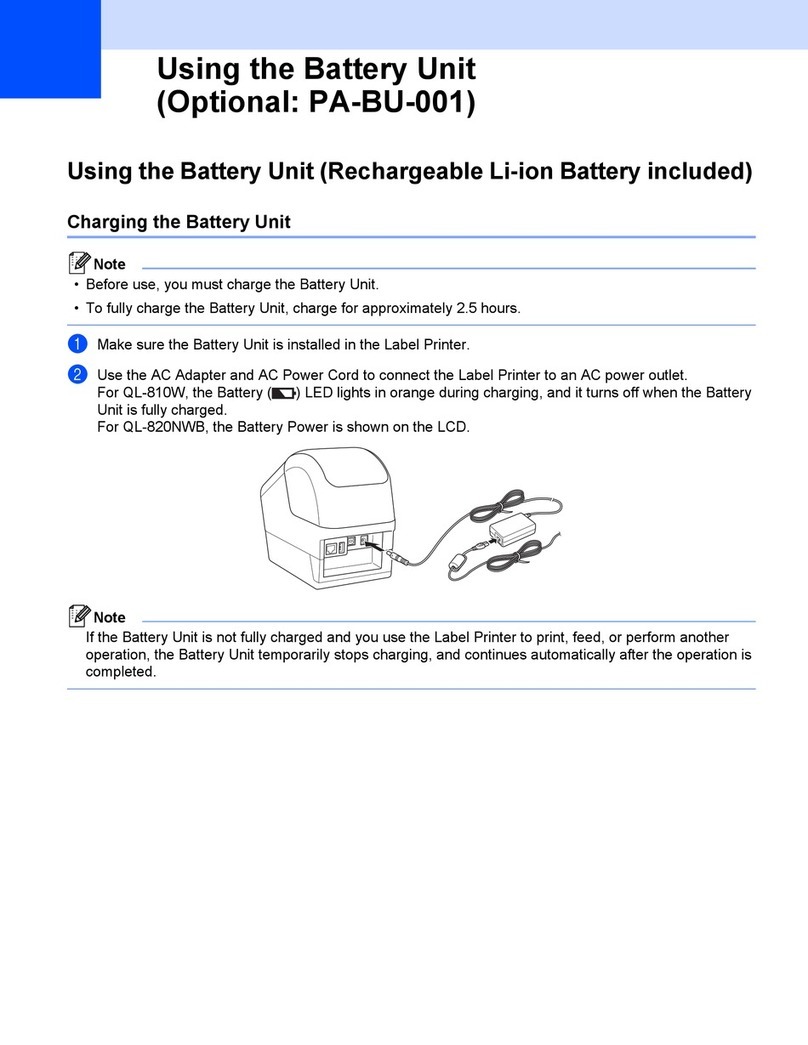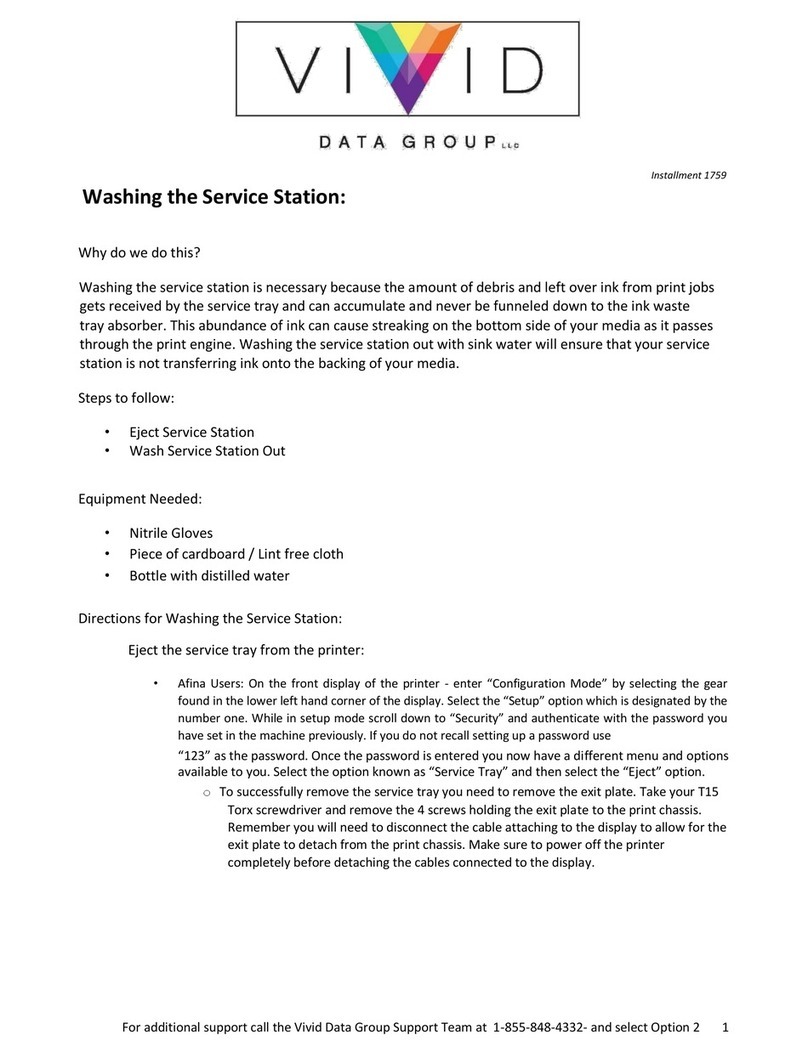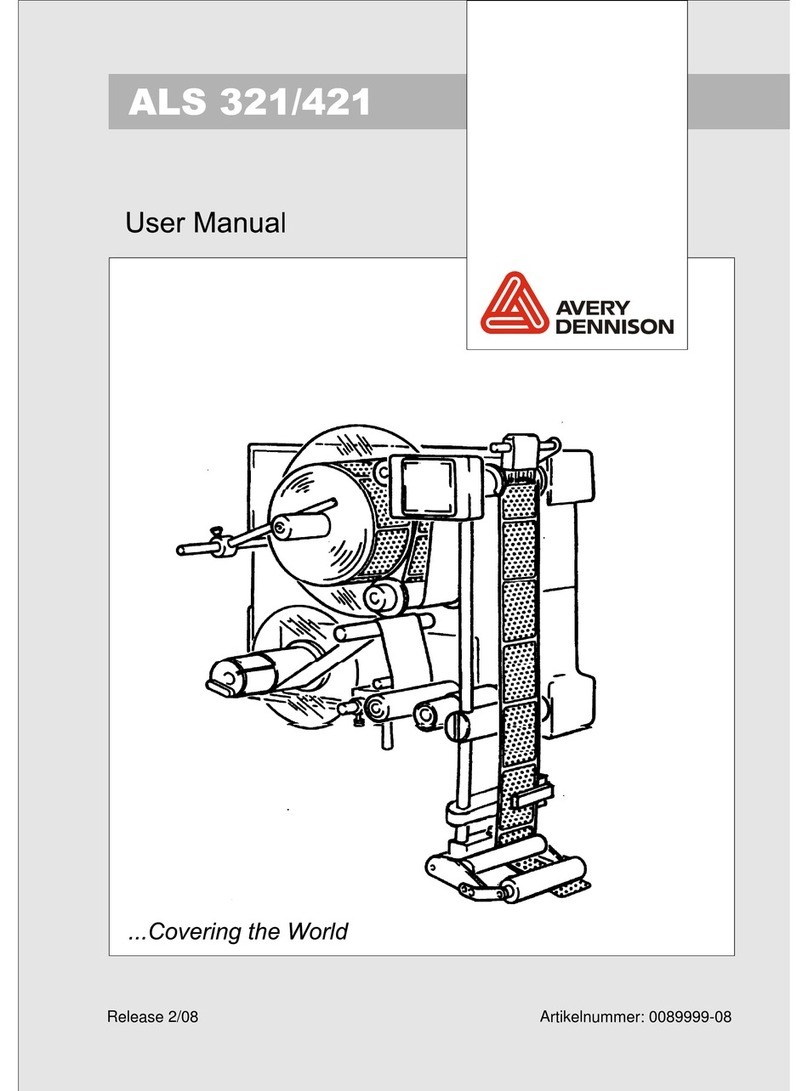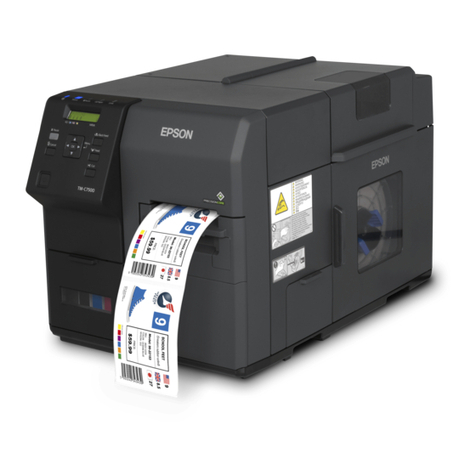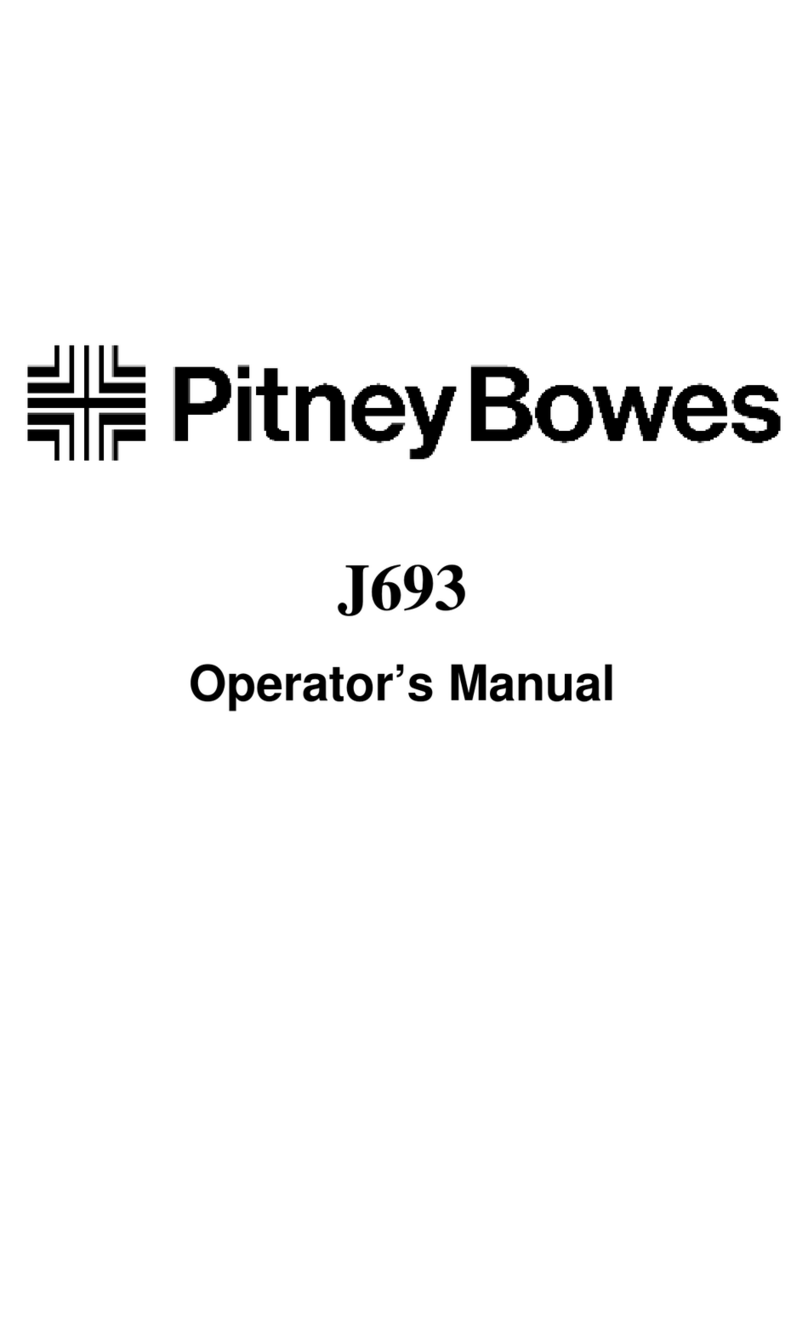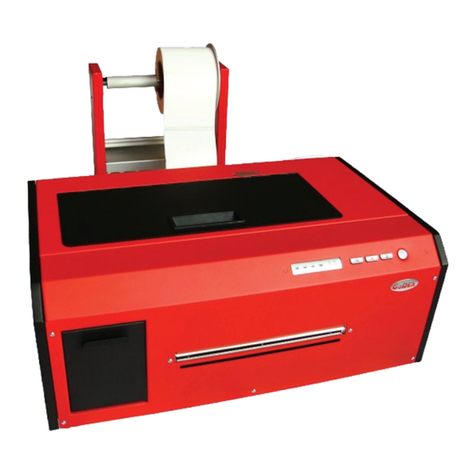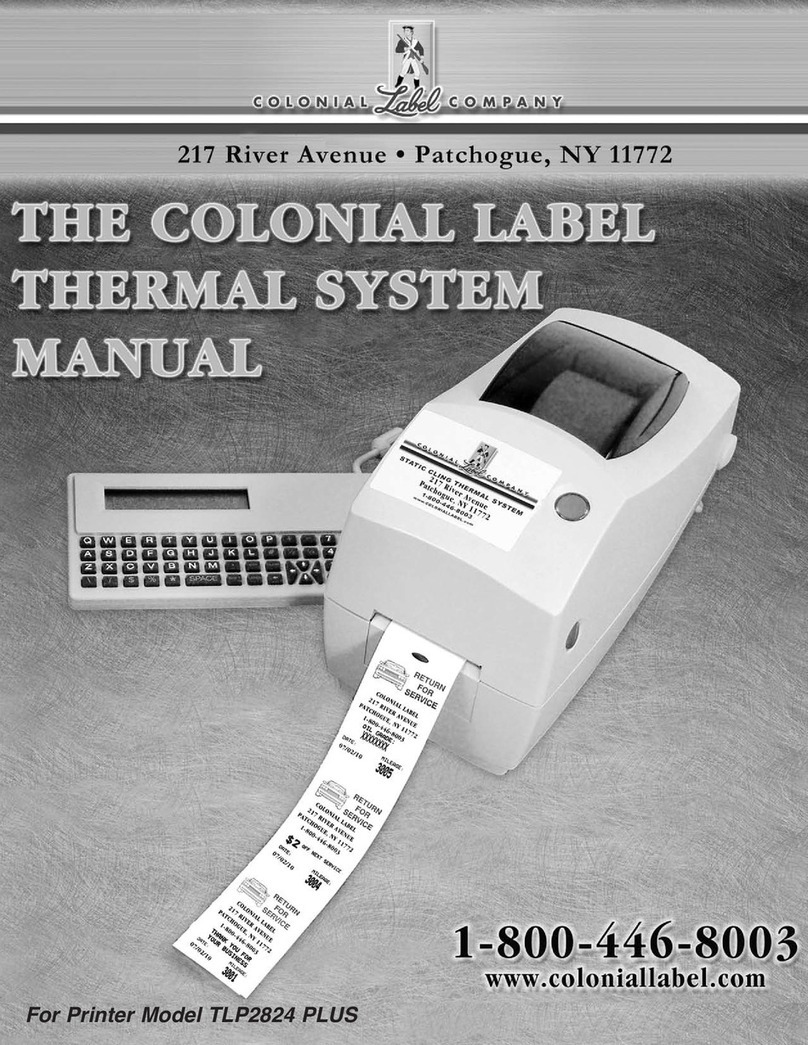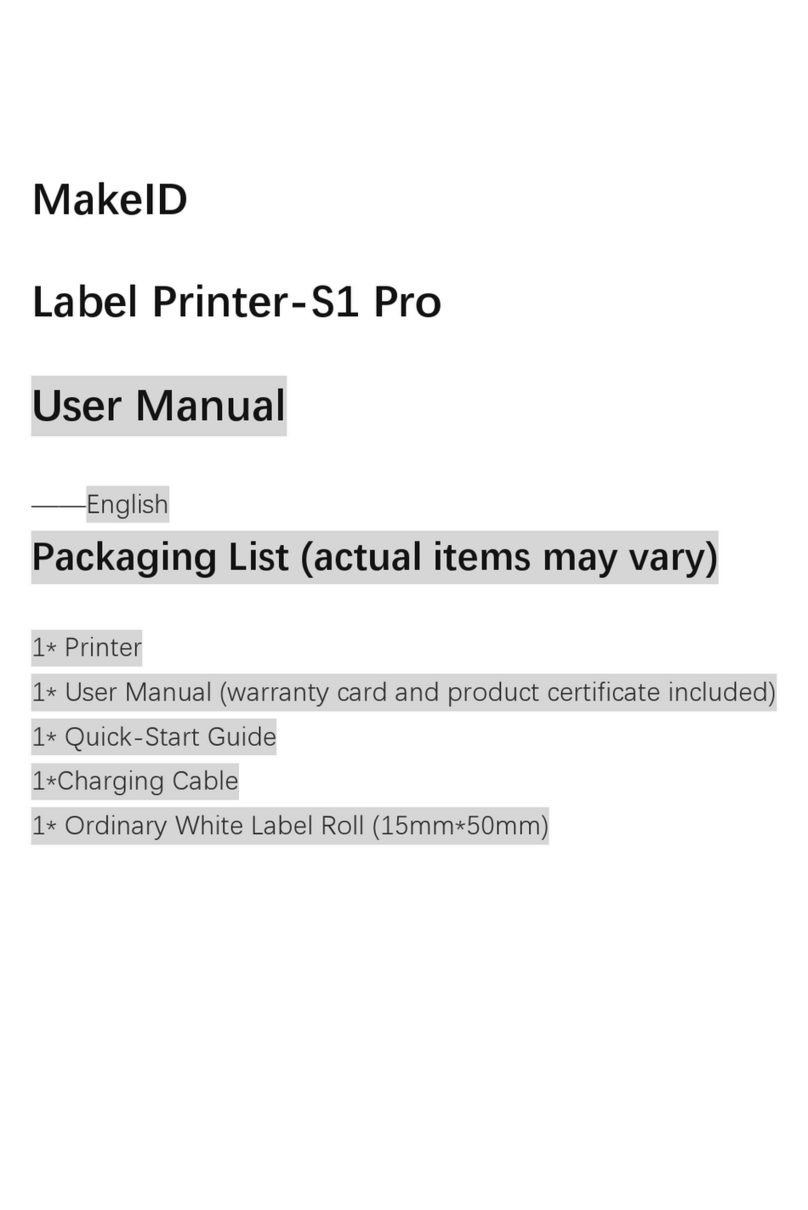Kroy K2500 User manual


i
Your Guarantee
Kroy Limited Warranty
Kroy LLC warrants its labeling system equipment against defects in
material and workmanship for a period of six (6) months from the date of
original purchase. At no charge to the customer, except for inbound
freight to Kroy's servie center, Kroy will, at Kroy's option, repair or
replace any product dtermined to be defective. Kroy will pay return UPS
ground charges. A purchase receipt or other evidence of purchase will
be required before warranty service is rendered. This warranty does not
cover cosmetic damage or any damage caused by accident, misse,
abuse, negligence or modification or attempted repair by anyone other
than Kroy or a Kroy authorized repair agent. THERE ARE NO EXPRESS
WARRANTIES EXCEPT AS SET FORTH IN THIS PARAGRAPH.
KROY SHALL NOT BE LIABLE FOR ANY INCIDENTAL OR
CONSEQUENTIAL DAMAGES FOR BREACH OF ANY EXPRESS OR
IMPLIED WARRANTY ON THIS PRODUCT. ALL EXPRESS AND
IMPLIED WARRANTIES, INCLUDING WARRANTIES OF
MERCHANTIBILITY AND FITNESS FOR A PARTICULAR PURPOSE
ARE LIMITED TO THE APPLICABLE WARRANTY PERIOD SET
FORTH ABOVE.
Some states do not allow the exclusion or limitation of incidental or
consequential damages, or limitaitons on how long an implied warranty
lasts, so the above exclusions or limitations may not apply to you. This
warranty gives you specific legal rights, and you may have other rights
which vary from state to state.If a problem develops with your Kroy
labeling system during or after this warranty period, you may contact
your Kroy dealer or Kroy's service center.
Your Guarantee
Every Kroy product is backed by the Kroy name, our innovative
leadership and our long-standing commitment to qualtiy.

ii
FCC Notice
This equipment generates and uses radio frequency energy and, if not
installed and used in strict accordance with these instructions, may
cause interference to radio and television reception. It has been tested
and found to comply with the limits for a Class B computing device
pursuant to Subpart J of Part 15 of the FCC Rules, which are designed
to provide reasonable protection against such interference in a
residential installation. However, there is no guarantee that interference
to radio or television reception, which can be determined by turning the
equipment off and on, will not occur. The user is encouraged to try to
correct the interference by using one or more of the following measures:
• Reorient or relocate the receiving antenna.
• Increase the separation between the equipment and the
receiver.
• Connect the equipment to an outlet on a branch circuit
different than the branch the receiver is connected to.
• Consult the dealer or an experienced radio/television
technician for help.
Note: To comply with FCC regulations, use only Kroy's recommended
serial cable when connecting the printer to a host computer (Kroy Part
Number 2506600). When installing the cable, the EMI filter should be
located 2-3" from the printer.
CDC Notice
This digital apparatus does not exceed Class B limits for radio noise for
digital devices as set out in the radio interference regulations of the
Canadian Department of Communications.
Le présent appareil numérique n’émet pas du bruits radioélectriques
dépassant les limites applicable aux appareils numériques de Classe B
prescrites dans le réglement sur le brouillage radioélectrique édicté par
le Ministére des Communications du Canada.
CDC Notice

iii
System Specifications
Input Device: 57 Key - Alpha-numeric elastomer keypad
Character Size: 6 point to 72 point, 1 inch supply
6 point to 55 point, .8 inch supply
scalable in 1 point increments
Print Tape: .5 inch (13 mm)
.8 inch (19 mm)
1 inch (24.5 mm)
LCD Display: 2 lines, 16 characters 5x7 dot matrix
Power Requirements: 7.5 - 9 VDC, 4A (Universal Power Adapter or
6 - C-size nickel-cadmium batteries)
Weight: 4 lbs 2 oz with batteries
3 lbs 2 oz without batteries
Memory: 450,000 characters
Communications: RS232/RS422
9600 Baud
Environment: Operating temperature 45 to 105°F (7 to 40°C)
Up to 90% non-condensing humidity
Storage temperature:
Machine: -20 to 150°F (-30 to 65°C)
Cartridge: 60 to 105°F (15 to 40°C)
System Specifications

iv
Important Safety Precautions
When using your printer, always follow these important safety
precautions:
1. Read all instructions carefully.
2. Do not immerse the printer or battery charger in water or other
liquids, you could receive an electrical shock.
3. Do not apply adhesive labels to your skin.
4. Do not put objects onto or into the printer or battery charger.
5. Do not expose to high temperatures or high humidity. Never leave on
the dashboard or in the trunk of your car.
6. Do not use in dusty places and avoid direct exposure to sunlight and
rain.
7. Do not pull on the tape, you could damage the tape cartridge.
8. Use only the batteries designated for the printer.
9. Do not attempt internal repairs to the printer or battery charger. If
service or repair is needed, contact a qualified Kroy service
representative.
10. Remove the batteries if you do not intend to use the printer for a long
time.
11. Do not touch the printhead ceramic or rollers with your fingers.
12. Do not attempt to charge batteries other than rechargeable nickel-
cadmium type.
13. Do not substitute other batteries or chargers.
Important Safety Precautions

v
Table of Contents
Warranty................................................................................................... i
Your Guarantee ....................................................................................... i
FCC Notice.............................................................................................. ii
CDC Notice ............................................................................................. ii
System Specifications .......................................................................... iii
Important Safety Precautions .............................................................. iv
Introduction ............................................................................................1
Setting Up Your Printer .........................................................................2
Connecting the Optional AC Adapter....................................................3
Installing the Batteries ..........................................................................3
Removing the yellow elastomer jacket ..............................................3
Installing the Nickel-Cadmium Batteries............................................4
Replacing the Lithium Battery............................................................5
Installing the Tape Cartridge.................................................................5
Loading a PCMCIA (PC) Card..............................................................6
Turning the Printer On and Off .............................................................7
Using Your Printer .................................................................................8
Understanding the Printer Display Screen............................................8
Using the Printer Keys ..........................................................................8
Default and Current Attribute Settings ................................................10
Using Function Keys ...........................................................................10
Working with Pages and Documents..................................................11
About Bar Code Labels.......................................................................12
Making Labels ......................................................................................13
Using F1..............................................................................................14
F1 ....................................................................................................14
New .................................................................................................14
Open................................................................................................14
Save ................................................................................................14
Delete ..............................................................................................15
Table of Contents

vi
Formatting Text ....................................................................................16
Using F2..............................................................................................17
F2 ....................................................................................................17
Font .................................................................................................17
Size..................................................................................................17
Justification......................................................................................18
Bold .................................................................................................18
Italics ...............................................................................................18
Mirror ...............................................................................................18
Vertical.............................................................................................18
Frame ..............................................................................................18
Underline .........................................................................................19
Changing Existing Text.......................................................................19
Setting Print Attributes........................................................................20
Using F3..............................................................................................21
F3 ....................................................................................................21
Density.............................................................................................21
Auto-off ............................................................................................21
Width ...............................................................................................22
Margin..............................................................................................22
Feed ................................................................................................23
Units ................................................................................................23
Sequence ........................................................................................23
Language.........................................................................................26
Copies .............................................................................................26
Rotation ...........................................................................................26
Baudrate ..........................................................................................27
Remote ............................................................................................28
Time/Date ........................................................................................29
Stamp ..............................................................................................29
Set Clock .........................................................................................29
24 Hour Mode..................................................................................30
Printing Labels .....................................................................................31
PRINT .................................................................................................31
FEED ..................................................................................................31
Setting Up Bar Codes ..........................................................................32
Using F4..............................................................................................33
F4 ....................................................................................................33
Code ................................................................................................33
Text..................................................................................................33
Table of Contents
Table of Contents

vii
Resolution........................................................................................34
Checksum........................................................................................34
Print Checksum ...............................................................................34
Security Level ..................................................................................34
Columns ..........................................................................................34
Using Die Cut Labels ...........................................................................35
Communication Protocol ....................................................................36
Serial Port Connection........................................................................36
Printer Set Up .....................................................................................37
Basic Operation ..................................................................................37
Conventions ..............................................................................37
Appendix A: System Messages ....................................................... A-1
Appendix B: Maintaining Your Printer ............................................ B-1
Cleaning Exterior Surfaces ............................................................... B-1
Cleaning the Cutting Mechanism ...................................................... B-1
Cleaning the Print Head and Rollers ................................................ B-3
Appendix C: Troubleshooting.......................................................... C-1
Self-Lamiating Wire Wrap Label Set-Up........................................... C-2
Saving Files in the K2500 .................................................................C-2
Appendix D: Code 128 Character Set.............................................. D-1
Appendix E: ASCII Character Set .................................................... E-1
List of Figures and Tables
Figure 1: Top View of Printer.................................................................2
Figure 2: AC Adapter Connection..........................................................3
Figure 3: Removing the Battery Cover ..................................................4
Figure 4: Battery Location .....................................................................4
Figure 5: Installing the Tape Cartridge ..................................................6
Figure 6: Loading PC Card....................................................................6
Figure 7: Removing the Cut Mechanism ........................................... B-2
Figure 8: Holding the Cut Mechanism ............................................... B-2
Figure 9: Cleaning the Cut Blade ...................................................... B-3
Table 1: Suggested Point Sizes...........................................................13
Table 2: Text Attributes........................................................................16
Table of Contents
Table of Contents

viii
Table 3: Print Attributes .......................................................................20
Table 4: Printing Sequential Labels .....................................................23
Table 5: Set Clock Parameters ............................................................30
Table 6: Bar Code Information.............................................................32
Table 7: Special Function Keys Hex Codes.........................................38
Table 8: Menu Hex Codes ...................................................................39
Table 9: File Menu ...............................................................................39
Table 10: Font Menu..............................................................................40
Table 11: Utilities Menu .........................................................................41
Table 12: Bar Code Menu......................................................................43
Table of Contents
Table of Contents

1
Introduction
Thank you for choosing the Kroy K2500 printer. Your new printer was
designed with your needs in mind, and offers many features to make
your work easier.
The printer provides features that are usually available only in larger
printers, yet it is small enough to hold comfortably in one hand. You can
use standard nickel-cadmium batteries for portability or an optional AC
power supply. Memory backup is provided by a lithium battery.
You can enter text easily using the keypad, and the special function keys
let you perform standard procedures quickly and easily. In just seconds
you can produce labels that include bolded, italicized, underlined,
mirrored and even framed text.
The K2500 lets you print labels in different widths and in either horizontal
or vertical orientations. The printer also contains a real-time clock and
ten of the most commonly used sets of bar codes.
You can also externally create labels and print them via an RS-232
connection. For more information about this feature, see
Communication Protocol or contact your authorized Kroy distributor.
Introduction

2
Setting Up Your Printer
This section explains how to set up your printer, connect the AC adapter,
install batteries, install a tape cartridge, load PCMCIA (PC) cards, and
turn the printer on and off.
Figure 1: Top View of Printer
NOTE: The printer contains an RS-232 port that you can use to connect
the printer to other equipment. For specific instructions on using this
feature, see Communication Protocol or contact your Kroy distributor.
Connecting the AC Adapter (optional)
Plug one end of the adapter into the printer (see Figure 2) and the other
end into an appropriate electrical wall outlet. Available from your Kroy
distributor.
Setting Up Your Printer
Cut Button
AC Adapter Jack
Tape Cartridge
RS-232 Port LCD Contrast
Control On/Off Button
Print Key
Keypad
Display Screen
PCMCIA
Card Slot

3Installing the Batteries
Setting Up Your Printer
Figure 2: AC Adapter Connection
Installing the Batteries
Your K2500 printer includes six 2.2 Ampere-hour "C" size nickel-
cadmium batteries for primary power, and one CR2032 lithium battery for
memory backup. Do not replace with other batteries. A suitable
battery charger is also included for recharging the nickel-cadmium
batteries.
WARNING: Do not dispose of nickel-cadmium batteries in fire, mutilate,
short-circuit, mix with other battery types, or charge in battery chargers
other than the charger supplied with this product - batteries may explode,
release toxic material, or get hot and cause personal injury.
Removing the yellow elastomer jacket.
1. Pull the jacket down from the top of the printer until clear of
the top portion of the printer.
2. While holding the printer from the bottom, grab the top
portion of the printer and lift it out of the jacket.
3. To replace the jacket reverse steps 1 and 2.
Note: The jacket must be removed to install/replace batteries.
Adapter Jack
Adapter Plug

4
Installing the Nickel-Cadmium Batteries
1. Remove the battery cover by pushing down on the arrow
and sliding it off the base in the direction of the arrow (see
Figure 3).
2. Insert the batteries (see Figure 4) according to the diagram
imprinted on the printer case*.
3. Replace the battery cover.
NOTE: The size and style of type you use for labels determine
how long the nickel-cadmium batteries will last between charges.
Large, bold characters require more power than small ones and
will drain the batteries faster. When the batteries run low, the
printer will display a message telling you so. Remove and
recharge them following the instructions provided with the
charger.
Figure 3: Removing the Battery Cover
Figure 4: Battery Location
* Diagram imprinted on printer case under batteries.
Installing the Batteries
Setting Up Your Printer
Lithium Battery
Nickel-Cadmium
Batteries*

5
Setting Up Your Printer
Installing the Tape Cartridge
Replacing the Lithium Battery
1. Turn the printer off and remove the battery cover by sliding it
off the base of the unit (see Figure 3).
2. Remove the lithium battery by prying and/or pulling it up and
out of its recess (see Figure 4).
3. Install the replacement making sure that its polarity is correct
(the same as the battery removed and in accordance with
the plus and minus signs molded into the battery compart-
ment next to the battery recess).
4. Replace the battery cover and re-enter any files that were
lost.
NOTE: The lithium battery normally lasts for several years and
requires replacement only after it will no longer retain files when
the unit is turned off.
CAUTION: Danger of explosion if lithium battery is incorrectly
replaced. Replace only with the same or equivalent type
recommended by the manufacturer. Discard used batteries
according to the manufacturer's instructions.
ATTENTION: "Danger d'explosion si les piles au Lithium sont
incorrectement réinstailées. Remplacer uniquement avec des
piles identiquas ou d'un modèle équivalent préconisé par le
constructeur. Suivre les instructions du constructeur pour retirer
les piles usées."
Return spent batteries to the dealer/manufacturer for appropriate
environmental disposal.
Installing the Tape Cartridge
1. Wind the ribbon spool on the bottom of the supply cartridge counter-
clockwise two full turns in the direction of the arrow with your finger.
2. Place the hole in the tape cartridge over the lock/release knob on the
printer while guiding the tape leader into the exit slot (see Figure 5).
Press down on the cartridge gently but firmly and make sure that it
lies flat against the base.
3. Turn the lock/release knob on the printer clockwise and align with the
closed lock graphic on the cartridge.
4. Press the FEED key once to advance the tape.

6
Figure 5: Installing the Tape Cartridge
Loading a PCMCIA (PC) Card
1. Turn off the printer. Warning: Do not remove or insert a card
with the printer on.
2. Insert the card into the card slot (see Figure 6) with the label side up.
Press gently but firmly to seat the card in the slot.
3. Turn on the printer.
Figure 6: Loading a PC Card (optional)
NOTE: The card must be loaded before you can select an option, fonts
or files from it, and should not be removed until you have printed the
label that uses the card.
Setting Up Your Printer
Installing an Application Card
Lock/Release
Knob
Supply Cartridge
Print Head
& Rollers
in this area
~
Exit Slot

7
Turning the Printer On and Off
Press the ON/OFF key located on the lower left hand corner of the
keypad to turn the printer on. The following prompt will appear:
Kroy K2500
Any Key
Press any key, except ON/OFF, SHIFT, CAPS or ALT, to begin. Press
the ON/OFF key again to turn the printer off.
Turning the Printer On and Off
Setting Up Your Printer

8
Using Your Printer
Understanding the Printer Display Screen
The printer display screen shows system prompts and messages, lists of
file names, menu options, and label text. Although you can enter six
lines of text on a label, the screen displays only two lines (16 characters
each) at a time and shows line numbers. Each time you press ENTER
the line number is displayed on the left followed by a colon. Use the left
and right arrow keys to view characters off the edge of the display
screen.
When the display screen is blank (except for the cursor and line number)
or shows your label text, you are in “edit” mode. You use edit mode to
enter or change label text. When you press one of the special function
keys, the menu of options will be displayed on the second line of the
display. After you finish selecting an attribute, the printer redisplays your
text and returns you to edit mode (except for Font menu (F2)).
Using the Printer Keys
The keyboard is used to enter label text and access menus. You will
hear an audible click whenever a key is depressed (except modifier
keys). The special keys on the keyboard are described below.
ALT (1) Enters special characters and accent symbols shown in yellow
on the keyboard bezel and (2) activates the DELETE function on the <
key (see <below). To enter a special character shown in yellow, hold
down ALT and press the key below and to the right of the character you
want. Accented characters require an extra step to enter. To enter an
accented character:
• hold down ALT and type the key below and to the right of
the accent character,
• release both keys, and,
• type the character to be accented (holding down the SHIFT
key will enter it in upper case).
Arrow Keys Move the cursor through text without changing it and
through options without selecting any. The left and right arrow keys
move left and right, one option or one character at a time; the up and
Using the Printer Keys

9
down arrow keys move up and down through lines of text, one line at a
time. When used with SHIFT, the up and down arrow keys act as PAGE
UP (previous label) and PAGE DOWN (next label) keys and the left and
right arrow keys move the cursor one word at a time.
CAPS Locks SHIFT on so that you can type all capital letters.
<(DELETE) Deletes the character to the left of the cursor. To delete
the character above the cursor, hold down ALT and press <. To delete
an entire line hold down SHIFT and press <, and to delete just one word
hold down ALT-SHIFT and press <.
ENTER (1) In edit mode, moves to the next line on a label when you are
entering label text, and (2) in function mode, selects menu options, file
names, and default attribute settings.
ESC Returns you to edit mode without selecting a list option or
changing an attribute and aborts printing. Note: When using F2, press
ESC twice (if you are in a submenu) to return to edit mode without
selecting a list option.
F1 Lets you create a label and save it in a file, modify labels you have
already saved, and delete labels that you no longer need.
F2 Lets you choose text attributes for your label text and remains on the
display until you press ESC. You can choose a font, font size,
justification, bold, italics, mirror, vertical, frame, and underlined text.
F3 Lets you specify the language you want to use, label width, margins,
unit of measure (inch or millimeters) for specifying label width and
margins, a sequence to print automatically, number of copies to print,
whether to automatically shut off after 5 minutes, variable feed length,
baud rate, remote mode, time and date functions, print density, and
rotation.
F4 Lets you set up the printer to print bar codes. You can select the
type of bar code you want to print, add text to print with the code, select
print resolution, and specify the type of error checking you want to use.
FEED Advances approximately one inch of tape from the printer.
PRINT Prints the current label and advances the tape far enough to
clear the cut mechanism. To abort printing, press ESC.
Using Your Printer
Using the Printer Keys

10
SHIFT (1) Capitalizes letters and, used with ALT, special language
characters (such as Æ) and accented characters (such as Ö) shown in
yellow on the keyboard bezel, (2) accesses characters (such as % and ;)
at the tops of number and punctuation keys, and (3) causes the up and
down arrow keys to function as PAGE UP (previous label) and PAGE
DOWN (next label) keys, (4) causes the left and right arrow keys to move
the cursor one word at a time.
Default and Current Attribute Settings
When the printer is shipped from the factory, some attributes are already
set; for example, the number of copies is set to one. Although you can
change these default settings when you make labels, they are
automatically reinstated when you turn off the printer or select NEW from
the file menu. The default settings for your printer are shown in the
Formatting Text and Setting Print Attributes sections of this manual.
"Current" settings are the attributes active right now, and can include (1)
factory defaults that you have not changed, (2) your changes to factory
defaults, and (3) your settings for attributes that are not preset at the
factory (i.e., width, margin). When you save a label, its current attributes
are automatically assigned to the next label you create (and all
subsequent labels) until you change attributes again or select New from
the file menu. Label text and text attribute settings are saved when you
shut off the printer. Factory settings are restored when the lithium
battery is replaced.
In some cases, the cursor displays to the left of the current settings when
you select a menu option; other times, current settings are marked by an
asterisk (*).
Using Function Keys
When you press one of the special function keys (F1,F2, F3 and F4), the
printer displays a menu of options. When you select an option, the
printer will display a list of more options, or prompt you for information.
These function keys also act as "toggles" which allow you to turn an
option on or off.
Using Your Printer
Using Function Keys

11
Submenu: A submenu is a subsequent menu of options that displays
when you press one of the special function keys. For example, when
you press F2 and then select the Justification option from the font
menu, a submenu of options displays the types of justification available:
Left, Center, or Right.
There are three ways to select options on menus and submenus: (1)
press ESC to retain the displayed default, (2) use the left or right arrow
keys to move the cursor to the left of the option you want and then press
ENTER, or (3) type the first capitalized letter in the option you want (such
as, Rfor Right justification in the preceding example).
Prompts: A prompt is the printer’s request for information. For example,
when you select the Save option on the file menu, the printer prompts
you to enter the name of the file you want to save. In response to a
prompt, simply type the requested information and press ENTER.
Toggles: Toggled options are like light switches — either on or off.
When you select an option (turn it on), an asterisk displays to the left of it
to show you that the option is on. When you select the option again (turn
it off), the asterisk is removed to show that the option is off.
At any menu, submenu, or toggle option, simply press ESC to return to
edit mode without changing the option setting. For example, if you press
F2 to display the font menu, type Jfor Justification, and then press
ESC, you return to edit mode without changing the current setting for
justification.
Working with Pages and Documents
You can enter multiple labels in a file by using PAGE UP and PAGE
DOWN to access additional pages (labels). In this case, you can think of
a file as a single document containing one or more pages (labels). (Each
label can be up to six lines.) To start a new page while you are in a file,
use the SHIFT and down arrow key to move to the next page; to move
back to the preceding page, use SHIFT and the up arrow key. When you
press the PRINT key, all pages in the file will be printed.
Note: PAGE UP and PAGE DOWN operate differently when using die
cut label supply. (See Using Die Cut Labels)
Using Your Printer
Working with Pages and Documents
Table of contents
Other Kroy Label Maker manuals
